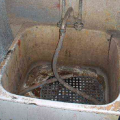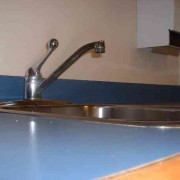Cross connection control
Since water quality is a matter of mutual concern and benefit, we recognized the need to develop and implement a comprehensive Cross Connection Control Program to protect water quality in the distribution system. Therefore, the program covers not only City Water Utility customers, but also the other water providers within our boundaries: Glenmore-Ellison Improvement District, Rutland Waterworks and Black Mountain Irrigation District.
This is a cooperative effort between plumbing and health officials, water providers, property owners and certified testers to establish and administer guidelines for controlling cross connections and implementing means to ensure their enforcement so the public potable water supply will be protected both in the city main and within buildings. The elements of the program define the type of protection required and responsibility for the administration and enforcement.
We employ a full time Cross Connection Control Program coordinator to develop, implement and maintain a program that focuses on industrial, commercial, institutional and agricultural water utility customers. The coordinator checks connections to determine whether pipes, vessels or other devices exist that would allow fluid contaminants to enter the water system by backflow.
Our plumbing inspectors ensure that adequate protective equipment is installed in new or renovated buildings. All installations are subject to yearly testing and inspection programs administered by the Cross Connection Control coordinator.
You may receive a letter stating that appropriate cross connection control assemblies must be installed on your property to comply with the City of Kelowna's Water Regulation Bylaw, or your cross connection devices are due for testing.
In both situations, contract a certified tester (i.e. journeyman plumber, mechanical contractor), who will install the cross connection control on the identified water supplies or test and submit the test report(s) to the water purveyor (you should also receive a copy of the report).
Generally, it’s the owner of the property or agent of the owner (i.e. property manager), or as identified in the lease agreement. If the cross connection control device belongs to the tenant, then the tenant should be responsible.
Yes, however each request must be presented in writing to the Cross Connection Control officer and will be individually assessed due to the factors involved (i.e. degree of hazard, type of protection, etc.).
Cross connection control devices have internal seals, springs and moving parts that are subject to fouling, wear or fatigue. Therefore, all cross connection control devices have to be tested periodically to ensure they’re functioning properly.
A cross connection is a direct arrangement of a piping line that allows the potable water supply to be connected to a line that contains a contaminant. An example is a common garden hose attached to a hose bib with the end of the hose lying in contaminated water.
There are some typical cross connections found in a residential home:
- Outdoors: The most common example in a home environment is a garden hose attached to an outside tap or hose bib, with the end of the hose connected to a pesticide sprayer or left submerged in an ornamental pool; underground lawn watering (irrigation) systems
- Indoor Fixtures: Laundry sink c/w hose, handheld shower heads immersed in water, alternative heating systems and auxiliary water sources
- Other: Boilers, fire protection systems and in-home water treatment (softeners) systems, high pressure washer, etc.
Yes. Essentially, all cross connection control devices cause some degree of pressure loss. The typical pressure drop across a device depends on the type, make, size and location of the device. Refer to the manufacturer’s literature.
- Air gap
- Atmospheric vacuum breakers (including hose connection vacuum breakers)
- Pressure vacuum breakers (including a backflow preventer with intermediate atmospheric vent for ½" and ¾" lines)
- Double check valve assembly
- Reduced pressure zone backflow preventers
An air gap is the physical separation of the potable and non-potable system by an air space. The vertical distance between the supply pipe and the flood level rim should be two times the diameter of the supply pipe, but never less than 1”. The air gap can be used on a direct or inlet connection and for all toxic substances.
System without an air gap

System with an air gap

Back-siphonage is the reversal of normal flow in a system caused by negative pressure (vacuum or partial vacuum) in the supply piping.
Back-siphonge can be created when water stops being supplied due to nearby fire-fighting, repairs or breaks in city mains, etc.; the effect is like sipping an ice cream soda by inhaling through a straw, which induces a flow in the opposite direction.
Backpressure is the reversal of normal flow in a system due to an increase in the downstream pressure above that of the supply pressure.
Backpressure-backflow is created when the downstream pressure exceeds the supply pressure, which is possible in installations such as heating systems, elevated tanks and pressure-producing systems. An example would be a hot water space heating boiler operating under 15-20 lbs. pressure, coincidental with a reduction of the city water supply below such pressure (or higher in most commercial boilers). As water tends to flow in the direction of least resistance, a backpressure-backflow condition would be created, and the contaminated boiler water would flow into the potable water supply.



